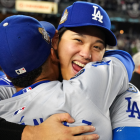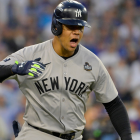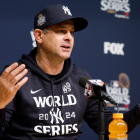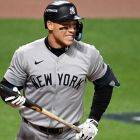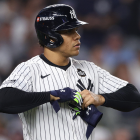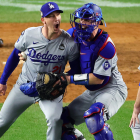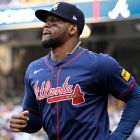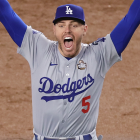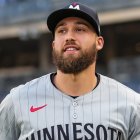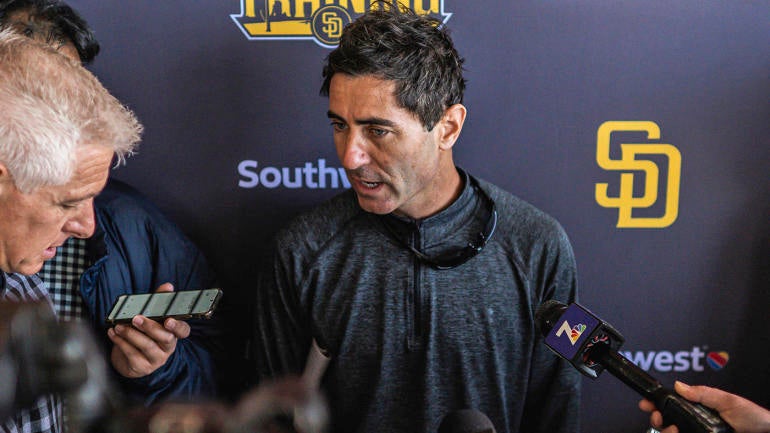
A few years back, a veteran scout told CBS Sports that San Diego Padres general manager A.J. Preller was adept at trading prospects he didn't like. For whatever reason, and who can say why the human brain captures some memories in snowcone fashion and lets others fall closer to the palm of the glove, that remark pops to mind whenever Preller makes a big deal – such as the one trade he orchestrated earlier this week, sending three youngsters to the Chicago White Sox in exchange for starter Dylan Cease.
To be fair, Preller has traded a lot of prospects during his time atop San Diego's baseball operations department. It stands to reason he's moved many, many young players that he liked. (Last year, talented scribe Zach Crizer noted: "There are 27 such former members of the organization – more than a full roster's worth – who have played elsewhere in the majors already this season and could theoretically still be under San Diego's team control.") Still, we've been waiting for the right time to examine Preller's track record of trading top prospects. The Cease trade gives us a good reason to do it.
Before we get to our findings, it's important to contextualize Preller. He's become one of the game's most often-discussed executives – both inside and outside the industry – for various reasons, including his recent propensity for acquiring as many star players as possible. Preller has also developed a reputation for being indefatigable, dating back to his days as a scout with the Texas Rangers, when he would spend an ungodly amount of time on the road. (The Padres, in turn, are said to demand a lot of their scouting staff.) Other executives theorize that, even now, Preller believes he can outwork and outscout everyone else as a means of gaining a competitive advantage.
How accurate is that characterization? Only Preller knows for sure. But that, plus his willingness to trade his top prospects in an era where most general managers over-index on surplus value, makes him a compelling executive. With that in mind, let's get to the point and take a look at Preller's history of trading top prospects. Here's a year-by-year breakdown of the players who were dealt within a year of being ranked inside the top five of the Padres' system by Baseball America. Do note that the players are listed in order of their ranking: the first player was the best ranked, and so on:
- Preseason 2015: RHP Matt Wisler, SS Trea Turner, RHP Joe Ross
- Preseason 2016: none
- Preseason 2017: none
- Preseason 2018: none
- Preseason 2019: INF Luis Urías
- Preseason 2020: OF Taylor Trammell, RHP Luis Patiño
- Preseason 2021: none
- Preseason 2022: SS CJ Abrams, OF Robert Hassell, OF James Wood
- Preseason 2023: none
- Preseason 2024: RHP Drew Thorpe
Fittingly, that's 10 top prospects traded in 10 years. Evaluating how each of the players has developed since is an uneven exercise – some were traded when they were on the cusp of the big leagues, others when they were still in their teens – and it's worth caveating that there's no guarantee the players would have met the same fate had they remained with the Padres. Nevertheless, let's proceed to break down the 10:
- Turner has been, by far, the best player of the pack. (He's also had as much time as anyone to prove it.) He's a two-time All-Star with more than 30 career Wins Above Replacement to his name. The Padres had selected him 13th overall just months before Preller took over. He quickly spun him off as a part of a three-team trade that netted the Padres Wil Myers, among other forgettable characters. It's fair to write that Preller wanted that one back as the years passed.
- Abrams doesn't have Turner's body of work (and he probably never will), but he's coming off a career-best season that saw him post a 95 OPS+ and earn 3.4 Wins Above Replacement. He's a dynamic offensive player who fell just two home runs short of a 20-40 season at the age of 22. The Padres have a loaded infield -- to the extent that top prospect Jackson Merrill has been converted to the outfield for the time being -- but some Padres fans might be more sensitive to feeling the sting of trading Abrams now that Juan Soto is no longer with San Diego.
- Wood and Thorpe have not yet debuted but remain promising prospects. CBS Sports recently ranked Wood, another member of that Soto deal, as the sixth best youngster in the minors on account of his immense strength and on-base skills. He has a superstar upside if everything clicks at the game's highest level. Thorpe, traded twice since the end of last season (including in the other Soto deal), isn't as highly acclaimed. He does have a devastating changeup and the chance to be a legitimate big-league starter with the White Sox sooner than later.
- Hassell, who Preller liked enough to draft eighth overall in 2020, also has not debuted. His stock has been trending down since even before the trade. Last season, he hit .221/.324/.321 while spending most of the year in Double-A. Hassell performed better in the Arizona Fall League, but even then he hit .290/.366/.348. His inability to convert his raw strength into in-game power, long a talking point, remains a critical weakness and one that could prevent him from having a meaningful career at the big-league level unless things change quickly.
- Urías had a couple of good seasons with the Brewers after being dealt for Trent Grisham. He's now on his third team in a year, though, suggesting he needs another gem soon to avoid falling off the radar entirely. We doubt the Padres would want to undo that one, given that Grisham performed better overall.
- Wisler had a few good seasons down the road as a reliever but did not live up to his prospect hype as a starter. He hasn't pitched in the majors since 2022. Ross, conversely, had a few solid seasons as a starter and remains in the majors. He's dealt with injuries throughout his career, to the extent that he won't make his 100th big-league appearance until this year -- when he's already amassed more than six years of major league service time.
- Trammell hasn't worked out at all, but we do think Preller regrets the trade that sent him – and more notably, Ty France and Andrés Muñoz – to the Mariners. The same isn't true for the swap that sent Patiño (now with the Padres again after falling off two other rosters) to the Rays, along with Francisco Mejía, Blake Hunt, and Cole Wilcox, for lefty and reigning Cy Young winner Blake Snell.
(We do feel obligated to note that our methodology was extremely limited here and didn't account for several other notable prospects that Preller has traded over time. Some, like Max Fried, developed into stars; others, like MacKenzie Gore, seem like solid big-league players; and even others, like Xavier Edwards, are below that.)
Trading Turner was regrettable, and time will tell on Abrams, Wood, and Thorpe. Overall, though, Preller probably hasn't traded from the top of his system as often as you might think, and when he has, he's done so without making many mistakes. Credit that to Preller's sharp eye, to luck, or whatever force or combination you want.
What does the above mean for the Cease trade? Probably not much – even if you think Preller's track record on top prospects is pure skill and holds predictive power, he's still erred before and likely will again. It does, however, mean that we'll continue to think about that scout's observation whenever Preller decides it's time to make a splash.









